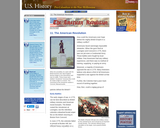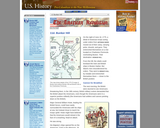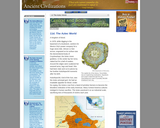
Note card on norms
- Subject:
- Career and Technical Education
- Criminal Justice
- Material Type:
- Interactive
- Provider:
- Michigan Virtual
- Date Added:
- 06/26/2019

Note card on norms

Public policy is a goal-oriented course of action that the government follows in dealing with a problem or issue in the country. Public policies are based on law, but many people other than legislators set them. Individuals, groups, and even government agencies that do not comply with policies can be penalized. This complicated process goes through a predictable series of steps:

Hit and Run Accident Example Slideshow

Criminology Notecards

Slides on Crime and Society

How could the Americans ever hope defeat the mighty British Empire in a military conflict? Americans faced seemingly impossible obstacles. When the guns fired at Lexington and Concord in 1775, there was not yet even a Continental Army. Those battles were fought by local militias. Few Americans had any military experience, and there was no method of training, supplying, or paying an army.

Criminology Slideshow

The British seemed unbeatable. During the previous 100 years, the British had enjoyed triumph after triumph over nations as powerful as France and Spain. At first glance, the odds were clearly against the Americans. A closer look provides insight into how the underdogs emerged victorious.

The Maya were a collection of people clustered in city-states. What united them was an idea. For the Maya the world of ordinary living and the Otherworld populated by gods, ancestors, and monstrous things, were equally real. There existed three regions, intricately bound together: the heavens, the earth, and the waters of the Underworld.

United States foreign policy has changed dramatically from George Washington's day. Although Americans always pay attention to the advice of their revered founder, the world is of course not the same. The many people that shape American foreign policy today accept the fact that the United States is a member of a world community that cannot afford to ignore the importance of getting along.

In the past 25 years archaeologists have learned to read what the Mayas wrote. Today we know the names of kings and queens, how they lived, and when they died, transforming our view of Maya culture.

Just as developing a coherent foreign policy is problematic in these post-Cold War days, so is the question of defending the country against possible danger from outside its borders. The avoidance of war, as indicated by the 1947 name change from "Department of War" to "Department of Defense" today holds the highest priority, and the hope that the United States can play a role in limiting violent upheavals around the world is reflected in both its foreign and military policies.

It is impossible to know the exact number of American colonists who favored or opposed independence. This section discusses attitudes toward the American Revolution in the colonies

Until the 20th century the country abided by the laissez-faire policy, which required a free market with little intervention from government. With the Great Depression came Keynesian economics, or the opposite belief that the government should manage the economy. Today, United States economic policy lies somewhere in between åÑ government should regulate and sometimes manage, but should allow a free market whenever possible. Political and business leaders disagree on how much control is enough.

Ready to fight at a moment's notice, minutemen began fighting early in the American Revolution. Their efforts at Lexington and Concord inspired many patriots to take up arms against Britain.

The Inca called their empire Tahuantinsuyu, or Land of the Four Quarters. It stretched 2,500 miles from Quito, Ecuador, to beyond Santiago, Chile. Within its domain were rich coastal settlements, high mountain valleys, rain-drenched tropical forests and the driest of deserts. The Inca controlled perhaps 10 million people, speaking a hundred different tongues. It was the largest empire on earth at the time. Yet when Pizarro executed its last emperor, Atahualpa, the Inca Empire was only 50 years old.

On the night of June 16, 1775, a detail of American troops acting under orders from Artemas Ward moved out of their camp, carrying picks, shovels, and guns. They entrenched themselves on a rise located on Charleston Peninsula overlooking Boston. Their destination: Bunker Hill.

Does the right to pursue happiness include access to a free public education? Do all Americans have an unalienable right to health care under this happiness umbrella? Should the unemployed be assisted in their times of need?

Huitzilopochtl, God of the Sun, was the Aztec principal god. He had an insatiable appetite for blood. Under his urging, the Aztecs rose from a band of primitive farmers to become the bloodiest civilization of the early Americas. Many Central America cultures indulged in human sacrifice. The Aztec practiced it on an industrial scale, sacrificing tens of thousands of victims each year.

In the wake of Columbus' historic voyage in 1492, expeditions, especially from Imperial Spain, swarmed into Aztec territory. They came in search of gold and souls gold to enrich the coffers of the Spanish king (and their own), and heathen souls to rescue for Christianity. Within a generation, America's ancient civilizations were crushed. Both the Aztec and Inca Empires collapsed after campaigns lasting just a couple of years. How did they fall so fast? Historians suggest many causes.